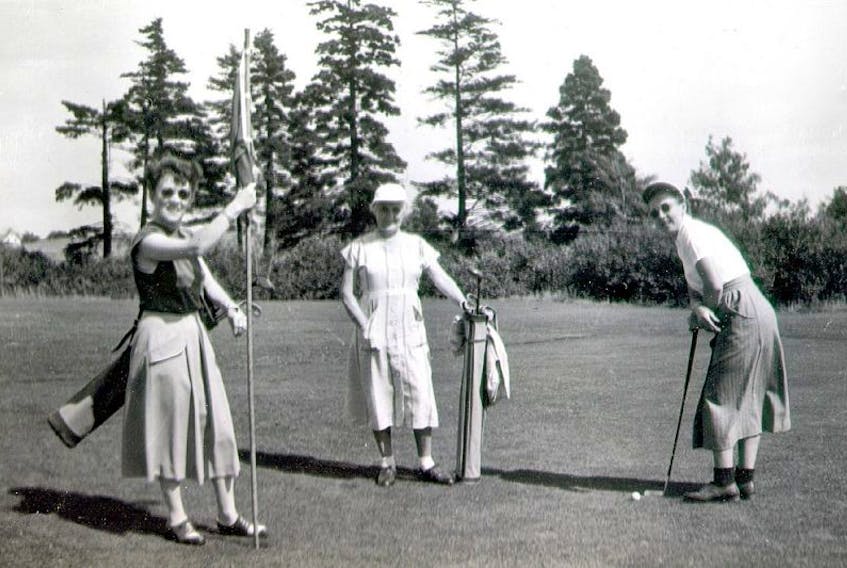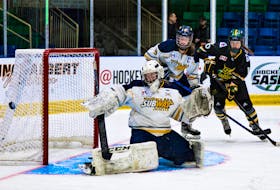After 106 years of providing accommodation for upwards of 300 members, the Sackville Golf and Country Club appears poised to continue well into the future after adopting a new model of operation. Like any other organization it has faced its ups and downs and is just now coming out of a tough period and is regrouping in a manner that bodes well for the future.
From a high of roughly 300 members as recently as four years ago, the numbers fell to a low of 180 last season, resulting in a major deficit of close to $40,000. However, reports from around the world indicate this is a phenomenon felt wherever the game is played.
Jack Drover, who heads the local club as president, says there are a number of factors in play resulting in fewer people playing the game on a regular basis. He believes that the time required to play the game well, the escalating cost of membership, an aging and decreasing population and family commitments are the major contributors.
There is no question about the time commitment. Once a person becomes “addicted” there is an urge to play on a consistent basis and this can mean three to four hours each outing. However, since the Sackville club is located so centrally golfers can slip out even during the noon lunch hour and manage to get in three or four holes. But this is unique and not many towns or cities can offer such a convenient plan – here reserving tee time is not required and seldom is there ever a delay in starting a round.
Like every other form of recreation the cost of membership is rising and this causes an average wage earner to think of priorities. Locally, the cost is minimal but still takes a fair bite out of one’s income. And naturally with a shrinking and aging population there are fewer people to take up the game. Family commitment is another major concern, especially if both parents are golfers.
Drover doesn’t mention another factor – the variety of alternatives available these days. Less than a half century ago there was little in the way of technical toys to play with and they have become all the rage – just go to any place where people congregate and try to start a conversation while most are texting, tweeting, Facebooking or emailing a friend.
Drover pointed out during a recent discussion of golf that it appears about the same number of people are playing the game, it is just that fewer are joining clubs but are taking advantage of reasonable green fees to play eight to 10 games a season.
As a result, the local club has come up with some imaginative ways to attract the “non-addicted” to try out the course with special deals that include the use of carts. This has created some new revenue, which can be used to improve facilities while membership fees are expected to about cover the cost of operation, which has been budgeted this year at $60,000.
“It seems that it no longer is it a privilege to play golf,” says Drover, “it is competitive and one has to be creative to meet the new challenges.”
And so this year the club’s budget has been adjusted by the previous executive to meet prevailing conditions. This has been expressed primarily in personnel cutbacks related to the operating model of the clubhouse.
For three seasons a professional golfer managed affairs but now much of this work is performed by volunteers. However, there are still five seasonal employees as well as two consultants who oversee the day-to-day operations of the course. Veteran golfer Kevin Read serves as the consultant for grounds and he has two long time employees – Peter Hicks and Tim Wheaton – while Debbie Stokes is clubhouse manager with Nikka Shaw and Spencer Betts as assistants. Brian Estabrooks is hired to maintain the equipment, while Jason Strathearn is the financial consultant.
The team of Steve Boorne and Drover oversee the business operation, which includes maintaining a stock of golfing items for sale among their many duties. They have streamlined the “pro shop” to make it more efficient and better suited to the needs of the members and visitors.
The club has also set up a new website and Facebook page in order to keep its members updated and provided with the latest information while an up-to-the-minute membership file is maintained.
Drover says it was obvious the old model of operation was not sustainable and so the transition calls for the executive to devote more time and attention to the details since the professional management style was too costly.
Expecting to lose six to eight senior members each year due to aging and with a decrease in the number of juniors due to a population decrease, a plan is in place to grow the numbers with special half season rates being well advertised beginning in August, while several incoming students to Mount Allison will be encouraged to join.
Times they are a changin’ – no doubt. For generations the Sackville Golf and Country Club was an elite or Old Boys Club that featured only professionals or successful businesspeople. That no longer is the case as the game has changed. And that is the goal of Drover and his fellow executive members, not only because it is the correct route but because it means success in the long term.
And there are some very good players in the club. For example, the veteran Susan Seaborn, who reigned for 19 years as the ladies champ of the Amherst Golf Club, recently aced the 165-yard number five hole. Using a six iron she and the remainder of her foursome watched as the ball landed and took a direct route to the hole. She finished the round with a neat 41 in spite of still recovering from recent hip surgery.
Yes, the game is still fun. It is the business of managing the operation efficiently that is the greater challenge. For the moment it appears as though Drover and his cohorts have things well in hand and the Sackville Golf Club should remain viable and provide the community with an outstanding form of recreation for generations to come much as it has for well over a century.
After 106 years of providing accommodation for upwards of 300 members, the Sackville Golf and Country Club appears poised to continue well into the future after adopting a new model of operation. Like any other organization it has faced its ups and downs and is just now coming out of a tough period and is regrouping in a manner that bodes well for the future.
From a high of roughly 300 members as recently as four years ago, the numbers fell to a low of 180 last season, resulting in a major deficit of close to $40,000. However, reports from around the world indicate this is a phenomenon felt wherever the game is played.
Jack Drover, who heads the local club as president, says there are a number of factors in play resulting in fewer people playing the game on a regular basis. He believes that the time required to play the game well, the escalating cost of membership, an aging and decreasing population and family commitments are the major contributors.
There is no question about the time commitment. Once a person becomes “addicted” there is an urge to play on a consistent basis and this can mean three to four hours each outing. However, since the Sackville club is located so centrally golfers can slip out even during the noon lunch hour and manage to get in three or four holes. But this is unique and not many towns or cities can offer such a convenient plan – here reserving tee time is not required and seldom is there ever a delay in starting a round.
Like every other form of recreation the cost of membership is rising and this causes an average wage earner to think of priorities. Locally, the cost is minimal but still takes a fair bite out of one’s income. And naturally with a shrinking and aging population there are fewer people to take up the game. Family commitment is another major concern, especially if both parents are golfers.
Drover doesn’t mention another factor – the variety of alternatives available these days. Less than a half century ago there was little in the way of technical toys to play with and they have become all the rage – just go to any place where people congregate and try to start a conversation while most are texting, tweeting, Facebooking or emailing a friend.
Drover pointed out during a recent discussion of golf that it appears about the same number of people are playing the game, it is just that fewer are joining clubs but are taking advantage of reasonable green fees to play eight to 10 games a season.
As a result, the local club has come up with some imaginative ways to attract the “non-addicted” to try out the course with special deals that include the use of carts. This has created some new revenue, which can be used to improve facilities while membership fees are expected to about cover the cost of operation, which has been budgeted this year at $60,000.
“It seems that it no longer is it a privilege to play golf,” says Drover, “it is competitive and one has to be creative to meet the new challenges.”
And so this year the club’s budget has been adjusted by the previous executive to meet prevailing conditions. This has been expressed primarily in personnel cutbacks related to the operating model of the clubhouse.
For three seasons a professional golfer managed affairs but now much of this work is performed by volunteers. However, there are still five seasonal employees as well as two consultants who oversee the day-to-day operations of the course. Veteran golfer Kevin Read serves as the consultant for grounds and he has two long time employees – Peter Hicks and Tim Wheaton – while Debbie Stokes is clubhouse manager with Nikka Shaw and Spencer Betts as assistants. Brian Estabrooks is hired to maintain the equipment, while Jason Strathearn is the financial consultant.
The team of Steve Boorne and Drover oversee the business operation, which includes maintaining a stock of golfing items for sale among their many duties. They have streamlined the “pro shop” to make it more efficient and better suited to the needs of the members and visitors.
The club has also set up a new website and Facebook page in order to keep its members updated and provided with the latest information while an up-to-the-minute membership file is maintained.
Drover says it was obvious the old model of operation was not sustainable and so the transition calls for the executive to devote more time and attention to the details since the professional management style was too costly.
Expecting to lose six to eight senior members each year due to aging and with a decrease in the number of juniors due to a population decrease, a plan is in place to grow the numbers with special half season rates being well advertised beginning in August, while several incoming students to Mount Allison will be encouraged to join.
Times they are a changin’ – no doubt. For generations the Sackville Golf and Country Club was an elite or Old Boys Club that featured only professionals or successful businesspeople. That no longer is the case as the game has changed. And that is the goal of Drover and his fellow executive members, not only because it is the correct route but because it means success in the long term.
And there are some very good players in the club. For example, the veteran Susan Seaborn, who reigned for 19 years as the ladies champ of the Amherst Golf Club, recently aced the 165-yard number five hole. Using a six iron she and the remainder of her foursome watched as the ball landed and took a direct route to the hole. She finished the round with a neat 41 in spite of still recovering from recent hip surgery.
Yes, the game is still fun. It is the business of managing the operation efficiently that is the greater challenge. For the moment it appears as though Drover and his cohorts have things well in hand and the Sackville Golf Club should remain viable and provide the community with an outstanding form of recreation for generations to come much as it has for well over a century.









